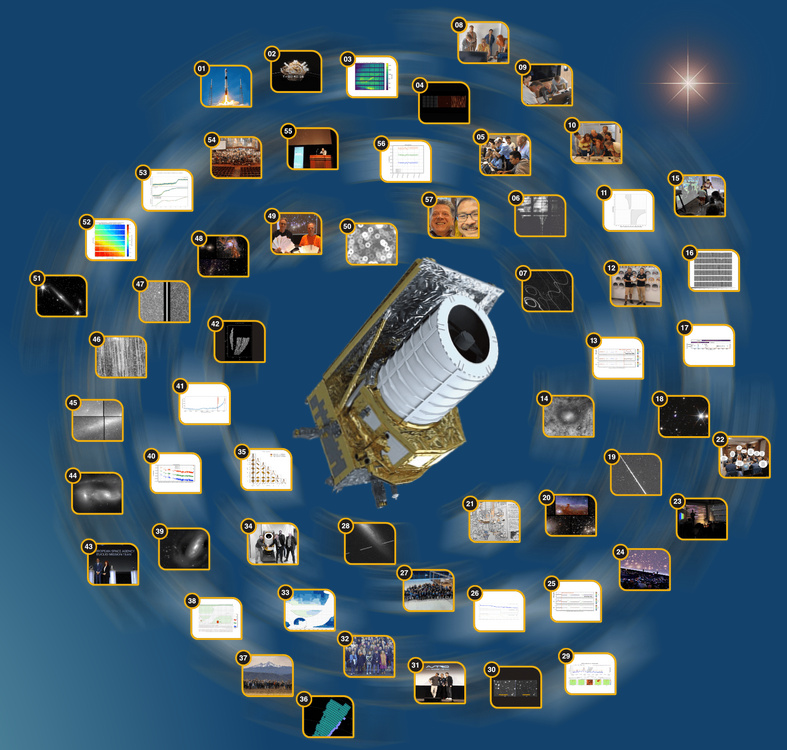What an exciting year this was for Euclid and the Euclid Consortium! In February Euclid’s surveys have officially started, the first 14 ‘Early Release Observation’ outreach and early science images have been made public, and now the consortium and ESA are gearing up for the first ‘Q1’ data release of 53 deg² to the world.
We know, “year end” summaries for a space mission are artificial, since Euclid will take no break and simply continues its orbit around the sun and carry out its surveys in January as it did in December. But it’s a good tradition to use this time of year for some stock taking and a look ahead into the coming year. So what has Euclid achieved in 2024 – or rather what do the 2000 people behind Euclid have achieved with a fully functioning space telescope in orbit? It’s been a lot.

Incidently, we’ve already celebrated Euclid’s first year in orbit earlier this year, with a one-per-week behind the scenes collection of images. “52 weeks of Euclid in space” walks us through Euclid’s and the Euclid Consortium’s first year after launch.
To recap 2024: first or all, Euclid was shown to fully function. Commissioning and first light had been completed in 2023, as had the first “phase diversity calibration” campaign. Euclid started its Wide Survey on February 14 and since then has been photographing the sky, half a square degree at a time. By mid March it had surpassed the area the Hubble Space Telescope has observed over more than 30 years of operations. Then there was a set back: ice! Water ice, originating from humidity Euclid had brought from Earth, had been building up on some of Euclid’s mirrors. A first decontamination campaign, where two mirrors were warmed up, immediately recovered 15% loss of light. But then it got worse. Instead of staying better, the transmission loss accelerated and both ESA and the Consortium were baffled. However, a second warming up removed this transmission loss again – but now the ice didn’t come back. Everyone is confident now that the “ice ages” have passed and since May Euclid’s transmission is mostly unchanged.
Also in May a big splash of papers was released by the Consortium and ESA’s independent legacy scientists. A set of five reference papers will be the basis of documenting Euclid’s mission, the instruments, as well as the sky simulations conducted for the mission. Alongside these, 10 first science papers based on Euclid Early Release Observations were published. From sub-stellar objects to gravitational lensing by galaxy clusters, the science spanned in these projects was wide and gave a glimpse into the scientific potential of the mission. These 15 papers and a few others will be collectively published in a special issue by Astronomy & Astrophysics in 2025.

The second set of five ERO images published by ESA in May 2024. The full-resolution images of a total of 14 targets can be found at ESA Sky.
Image credit: ESA/Euclid/Euclid Consortium/NASA, image processing by J.-C. Cuillandre (CEA Paris-Saclay), G. Anselmi
Talking about publications. 29 further refereed articles from inside the Consortium appeared in 2024, as well as four technical proceedings of the SPIE, and another 20 manuscripts that were submitted or already accepted for publications, which all can be read on the arXiv or ADS (but we also keep the EC’s publication page up to date). Did you know that Euclid has a binding policy that all refereed publications must be fully open access? And that ESA has a page which provides a collection of Euclid’s SPIE papers?
Aside from science work with regular photons, Euclid also noticed X-rays and protons from the Sun and the Milky Way, so we also have a solar observatory! But this is not impacting the data beyond what can be dealt with. Which is particularly important since for the next year and a half the Sun will be in its activity maximum.
Since February Euclid has now been pointed at more than 1000 deg² on the sky, and these data were put through the Euclid software of the Science Ground Segment. This huge suite of data processing has been in development since about a decade and is now quickly being improved step by step, taking into account the real-world properties of Euclid VIS and NISP data, and turning the raw data into science-ready data products. The first 53 deg², a single pass over the Euclid Deep Fields, has been fully treated and has been released to the EC scientists in November for long-planned first science projects. The same “Q1” dataset will be made public to the world on the 19th of March 2025. At this point many scientists and engineers are hustling to get paper drafts of science and technical data release papers in shape for mid-January, so all documentation and first science can be released alongside the data. This includes the first Euclid citizen science projects that have already provided valuable input to these projects.
2025 will be busy, like 2024. The Consortium and the world will be able to come to grips with the vast amount of observational data that Euclid creates every day. Data volumes are large, as is the number of interesting science projects. In fall 2025 the first large data release DR1 is expected by the Consortium, with the same data – then fully vetted – will go to the world in 2026. Until then, or until the Q1-release in March, there will always be the zoom into the first 1% of Euclid’s observations, that was published in November – and with more than 1.7 million views has already been advanced to one of ESA’s most popular videos ever.
Have a good start into 2025!

Euclid’s “Early Release Observation” view of the Horsehead Reindeer Nebula in Orion.
Image Credits: ESA/Euclid/Euclid Consortium/NASA, image processing by J.-C. Cuillandre (CEA Paris-Saclay), G. Anselmi; Hat from freepik.com.


